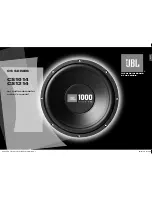
4
fig. 2
CONNECTION
With its active crossover and many connection and adjustment options, the subwoofer can
integrate seamlessly with any type of main loudspeaker. Level and crossover frequency can
be adjusted to match your main speakers and you can choose between active and passive
crossovers.
There are two ways to connect the subwoofer to your amplifier: The subwoofer can accept
either a line-level signal via its phono sockets from a preamplifier/surround decoder (fig. 1
and 2) or a speaker-level signal via its speaker input terminals from the speaker outputs of
an integrated amplifier/receiver or power amplifier (fig. 3 and 4). The subwoofer automatically
selects the active input. Do not connect line-level and speaker-level inputs at the same time.
There are two ways to connect your main speakers to the subwoofer: A power amplifier
connected to line-level outputs of the subwoofer can drive the speakers (fig. 1 and 4) or the
speakers can be connected directly to the speaker outputs of the SWA subwoofer (fig. 3). If
the line-level inputs on the subwoofer are used, then the speaker outputs cannot be used.
If the subwoofer is connected to a dedicated subwoofer output, then the main speakers
should not be connected to the subwoofer at all (fig. 2).
Fully active connection (See fig. 1): The
subwoofer receives a line-level signal
from a preamp/surround decoder. The
line-level outputs of the subwoofer del-
iver a high-pass filtered signal to a power
amplifier which drives the main speakers.
This is the preferred connection method,
because it fully exploits the advantages
of the built-in active crossover in the sub-
woofer.
Alternative active connection (See fig. 2):
If a separate subwoofer output is available,
it should be connected to the line inputs
of the subwoofer. The main speakers are
not connected to the subwoofer, but
directly to the amplifier. See the amplifiers
manual for additional information. Sepa-
rate subwoofer outputs are typically found
on surround decoders/amplifiers/
receivers.
fig. 1
All manuals and user guides at all-guides.com


























